Comprehensive Business Strategy Analysis: John Lewis Retail Firm
VerifiedAdded on 2023/01/13
|12
|3797
|80
Report
AI Summary
This report provides a strategic analysis of John Lewis, a UK-based retail firm. It begins with an introduction to business strategy and its importance, followed by a PESTLE analysis of the macro-environment, examining political, economic, social, technological, legal, and environmental factors impacting the company. The report then delves into an internal analysis using the SWOT framework, identifying John Lewis's strengths, weaknesses, opportunities, and threats. An industry analysis using Porter's Five Forces is also included to assess the competitive landscape. Furthermore, the report explores strategic planning using the Ansoff Matrix, evaluating market penetration, market expansion, product expansion, and diversification strategies, and concludes with the recommendation of market penetration as the most suitable strategy. The report also touches on the Bowman's strategic clock model. The project aims to provide a comprehensive understanding of John Lewis's strategic approach and its position within the retail sector.
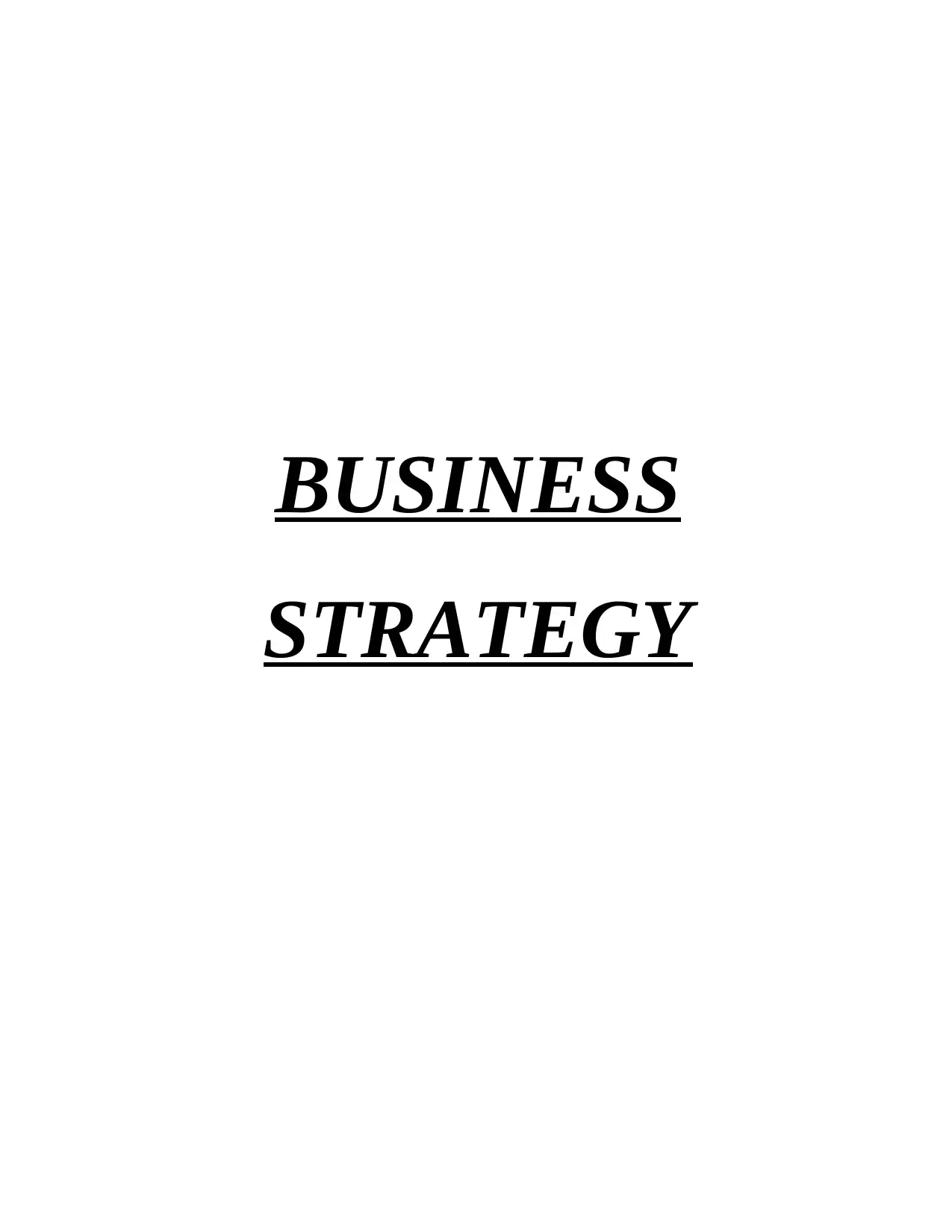
BUSINESS
STRATEGY
STRATEGY
Paraphrase This Document
Need a fresh take? Get an instant paraphrase of this document with our AI Paraphraser
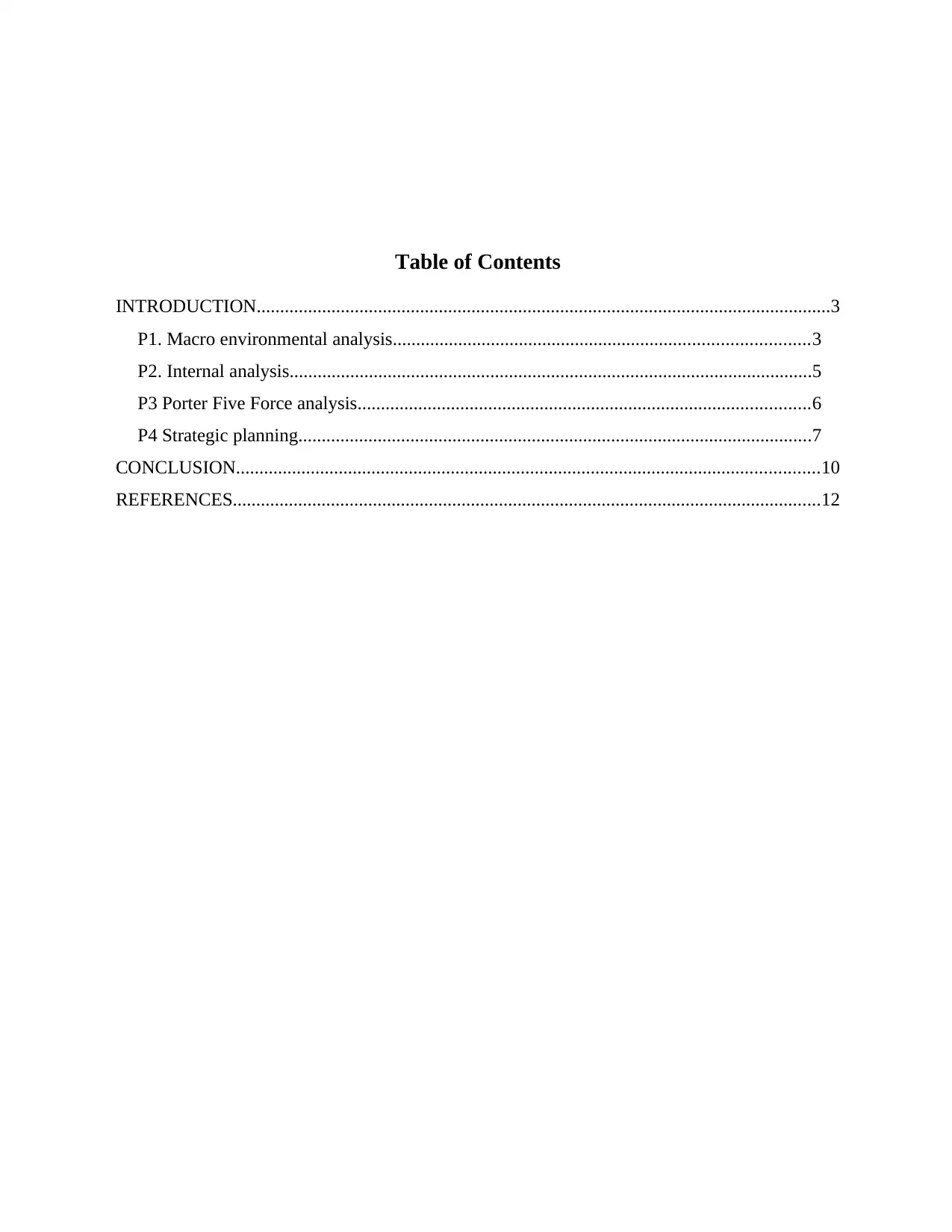
Table of Contents
INTRODUCTION...........................................................................................................................3
P1. Macro environmental analysis.........................................................................................3
P2. Internal analysis................................................................................................................5
P3 Porter Five Force analysis.................................................................................................6
P4 Strategic planning..............................................................................................................7
CONCLUSION.............................................................................................................................10
REFERENCES..............................................................................................................................12
INTRODUCTION...........................................................................................................................3
P1. Macro environmental analysis.........................................................................................3
P2. Internal analysis................................................................................................................5
P3 Porter Five Force analysis.................................................................................................6
P4 Strategic planning..............................................................................................................7
CONCLUSION.............................................................................................................................10
REFERENCES..............................................................................................................................12
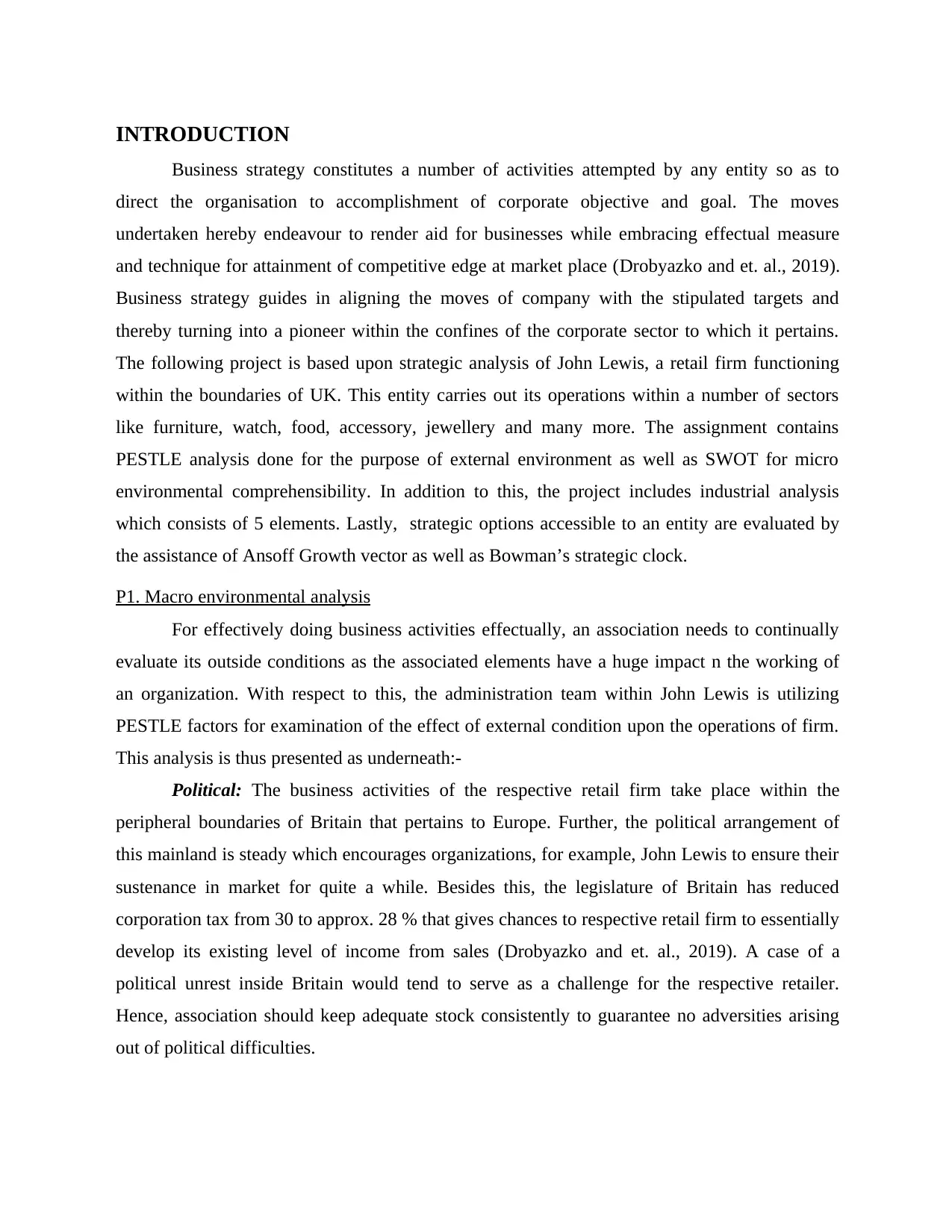
INTRODUCTION
Business strategy constitutes a number of activities attempted by any entity so as to
direct the organisation to accomplishment of corporate objective and goal. The moves
undertaken hereby endeavour to render aid for businesses while embracing effectual measure
and technique for attainment of competitive edge at market place (Drobyazko and et. al., 2019).
Business strategy guides in aligning the moves of company with the stipulated targets and
thereby turning into a pioneer within the confines of the corporate sector to which it pertains.
The following project is based upon strategic analysis of John Lewis, a retail firm functioning
within the boundaries of UK. This entity carries out its operations within a number of sectors
like furniture, watch, food, accessory, jewellery and many more. The assignment contains
PESTLE analysis done for the purpose of external environment as well as SWOT for micro
environmental comprehensibility. In addition to this, the project includes industrial analysis
which consists of 5 elements. Lastly, strategic options accessible to an entity are evaluated by
the assistance of Ansoff Growth vector as well as Bowman’s strategic clock.
P1. Macro environmental analysis
For effectively doing business activities effectually, an association needs to continually
evaluate its outside conditions as the associated elements have a huge impact n the working of
an organization. With respect to this, the administration team within John Lewis is utilizing
PESTLE factors for examination of the effect of external condition upon the operations of firm.
This analysis is thus presented as underneath:-
Political: The business activities of the respective retail firm take place within the
peripheral boundaries of Britain that pertains to Europe. Further, the political arrangement of
this mainland is steady which encourages organizations, for example, John Lewis to ensure their
sustenance in market for quite a while. Besides this, the legislature of Britain has reduced
corporation tax from 30 to approx. 28 % that gives chances to respective retail firm to essentially
develop its existing level of income from sales (Drobyazko and et. al., 2019). A case of a
political unrest inside Britain would tend to serve as a challenge for the respective retailer.
Hence, association should keep adequate stock consistently to guarantee no adversities arising
out of political difficulties.
Business strategy constitutes a number of activities attempted by any entity so as to
direct the organisation to accomplishment of corporate objective and goal. The moves
undertaken hereby endeavour to render aid for businesses while embracing effectual measure
and technique for attainment of competitive edge at market place (Drobyazko and et. al., 2019).
Business strategy guides in aligning the moves of company with the stipulated targets and
thereby turning into a pioneer within the confines of the corporate sector to which it pertains.
The following project is based upon strategic analysis of John Lewis, a retail firm functioning
within the boundaries of UK. This entity carries out its operations within a number of sectors
like furniture, watch, food, accessory, jewellery and many more. The assignment contains
PESTLE analysis done for the purpose of external environment as well as SWOT for micro
environmental comprehensibility. In addition to this, the project includes industrial analysis
which consists of 5 elements. Lastly, strategic options accessible to an entity are evaluated by
the assistance of Ansoff Growth vector as well as Bowman’s strategic clock.
P1. Macro environmental analysis
For effectively doing business activities effectually, an association needs to continually
evaluate its outside conditions as the associated elements have a huge impact n the working of
an organization. With respect to this, the administration team within John Lewis is utilizing
PESTLE factors for examination of the effect of external condition upon the operations of firm.
This analysis is thus presented as underneath:-
Political: The business activities of the respective retail firm take place within the
peripheral boundaries of Britain that pertains to Europe. Further, the political arrangement of
this mainland is steady which encourages organizations, for example, John Lewis to ensure their
sustenance in market for quite a while. Besides this, the legislature of Britain has reduced
corporation tax from 30 to approx. 28 % that gives chances to respective retail firm to essentially
develop its existing level of income from sales (Drobyazko and et. al., 2019). A case of a
political unrest inside Britain would tend to serve as a challenge for the respective retailer.
Hence, association should keep adequate stock consistently to guarantee no adversities arising
out of political difficulties.
⊘ This is a preview!⊘
Do you want full access?
Subscribe today to unlock all pages.

Trusted by 1+ million students worldwide
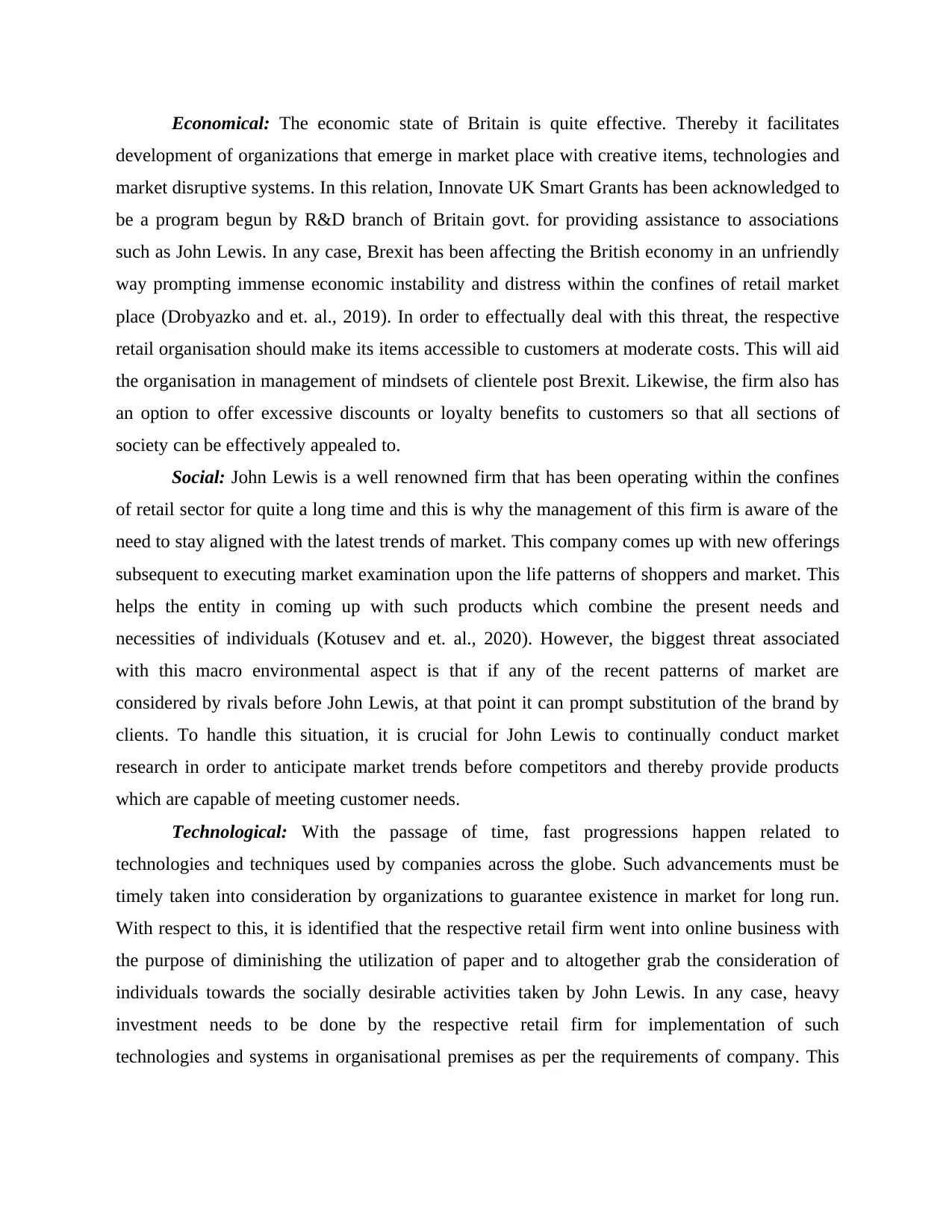
Economical: The economic state of Britain is quite effective. Thereby it facilitates
development of organizations that emerge in market place with creative items, technologies and
market disruptive systems. In this relation, Innovate UK Smart Grants has been acknowledged to
be a program begun by R&D branch of Britain govt. for providing assistance to associations
such as John Lewis. In any case, Brexit has been affecting the British economy in an unfriendly
way prompting immense economic instability and distress within the confines of retail market
place (Drobyazko and et. al., 2019). In order to effectually deal with this threat, the respective
retail organisation should make its items accessible to customers at moderate costs. This will aid
the organisation in management of mindsets of clientele post Brexit. Likewise, the firm also has
an option to offer excessive discounts or loyalty benefits to customers so that all sections of
society can be effectively appealed to.
Social: John Lewis is a well renowned firm that has been operating within the confines
of retail sector for quite a long time and this is why the management of this firm is aware of the
need to stay aligned with the latest trends of market. This company comes up with new offerings
subsequent to executing market examination upon the life patterns of shoppers and market. This
helps the entity in coming up with such products which combine the present needs and
necessities of individuals (Kotusev and et. al., 2020). However, the biggest threat associated
with this macro environmental aspect is that if any of the recent patterns of market are
considered by rivals before John Lewis, at that point it can prompt substitution of the brand by
clients. To handle this situation, it is crucial for John Lewis to continually conduct market
research in order to anticipate market trends before competitors and thereby provide products
which are capable of meeting customer needs.
Technological: With the passage of time, fast progressions happen related to
technologies and techniques used by companies across the globe. Such advancements must be
timely taken into consideration by organizations to guarantee existence in market for long run.
With respect to this, it is identified that the respective retail firm went into online business with
the purpose of diminishing the utilization of paper and to altogether grab the consideration of
individuals towards the socially desirable activities taken by John Lewis. In any case, heavy
investment needs to be done by the respective retail firm for implementation of such
technologies and systems in organisational premises as per the requirements of company. This
development of organizations that emerge in market place with creative items, technologies and
market disruptive systems. In this relation, Innovate UK Smart Grants has been acknowledged to
be a program begun by R&D branch of Britain govt. for providing assistance to associations
such as John Lewis. In any case, Brexit has been affecting the British economy in an unfriendly
way prompting immense economic instability and distress within the confines of retail market
place (Drobyazko and et. al., 2019). In order to effectually deal with this threat, the respective
retail organisation should make its items accessible to customers at moderate costs. This will aid
the organisation in management of mindsets of clientele post Brexit. Likewise, the firm also has
an option to offer excessive discounts or loyalty benefits to customers so that all sections of
society can be effectively appealed to.
Social: John Lewis is a well renowned firm that has been operating within the confines
of retail sector for quite a long time and this is why the management of this firm is aware of the
need to stay aligned with the latest trends of market. This company comes up with new offerings
subsequent to executing market examination upon the life patterns of shoppers and market. This
helps the entity in coming up with such products which combine the present needs and
necessities of individuals (Kotusev and et. al., 2020). However, the biggest threat associated
with this macro environmental aspect is that if any of the recent patterns of market are
considered by rivals before John Lewis, at that point it can prompt substitution of the brand by
clients. To handle this situation, it is crucial for John Lewis to continually conduct market
research in order to anticipate market trends before competitors and thereby provide products
which are capable of meeting customer needs.
Technological: With the passage of time, fast progressions happen related to
technologies and techniques used by companies across the globe. Such advancements must be
timely taken into consideration by organizations to guarantee existence in market for long run.
With respect to this, it is identified that the respective retail firm went into online business with
the purpose of diminishing the utilization of paper and to altogether grab the consideration of
individuals towards the socially desirable activities taken by John Lewis. In any case, heavy
investment needs to be done by the respective retail firm for implementation of such
technologies and systems in organisational premises as per the requirements of company. This
Paraphrase This Document
Need a fresh take? Get an instant paraphrase of this document with our AI Paraphraser
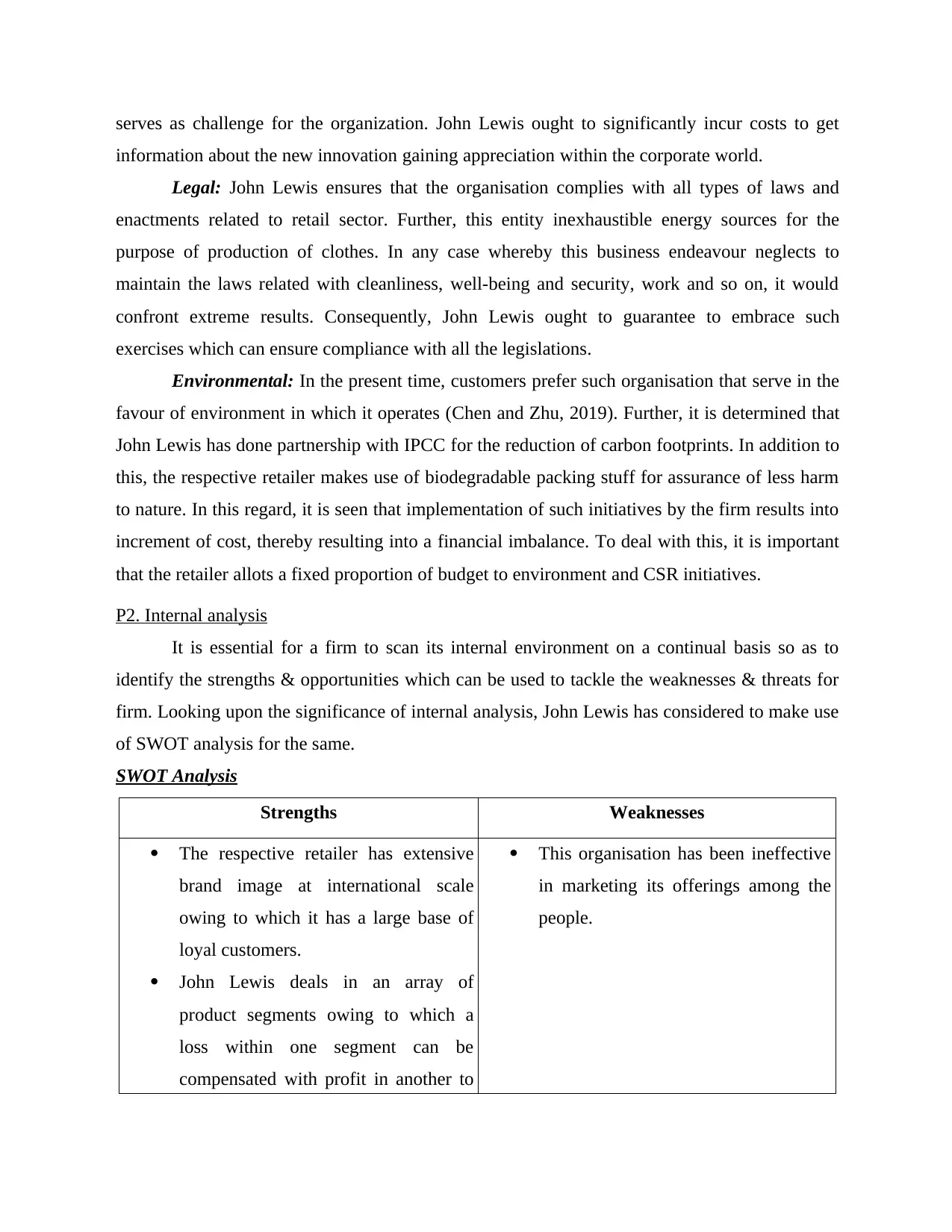
serves as challenge for the organization. John Lewis ought to significantly incur costs to get
information about the new innovation gaining appreciation within the corporate world.
Legal: John Lewis ensures that the organisation complies with all types of laws and
enactments related to retail sector. Further, this entity inexhaustible energy sources for the
purpose of production of clothes. In any case whereby this business endeavour neglects to
maintain the laws related with cleanliness, well-being and security, work and so on, it would
confront extreme results. Consequently, John Lewis ought to guarantee to embrace such
exercises which can ensure compliance with all the legislations.
Environmental: In the present time, customers prefer such organisation that serve in the
favour of environment in which it operates (Chen and Zhu, 2019). Further, it is determined that
John Lewis has done partnership with IPCC for the reduction of carbon footprints. In addition to
this, the respective retailer makes use of biodegradable packing stuff for assurance of less harm
to nature. In this regard, it is seen that implementation of such initiatives by the firm results into
increment of cost, thereby resulting into a financial imbalance. To deal with this, it is important
that the retailer allots a fixed proportion of budget to environment and CSR initiatives.
P2. Internal analysis
It is essential for a firm to scan its internal environment on a continual basis so as to
identify the strengths & opportunities which can be used to tackle the weaknesses & threats for
firm. Looking upon the significance of internal analysis, John Lewis has considered to make use
of SWOT analysis for the same.
SWOT Analysis
Strengths Weaknesses
The respective retailer has extensive
brand image at international scale
owing to which it has a large base of
loyal customers.
John Lewis deals in an array of
product segments owing to which a
loss within one segment can be
compensated with profit in another to
This organisation has been ineffective
in marketing its offerings among the
people.
information about the new innovation gaining appreciation within the corporate world.
Legal: John Lewis ensures that the organisation complies with all types of laws and
enactments related to retail sector. Further, this entity inexhaustible energy sources for the
purpose of production of clothes. In any case whereby this business endeavour neglects to
maintain the laws related with cleanliness, well-being and security, work and so on, it would
confront extreme results. Consequently, John Lewis ought to guarantee to embrace such
exercises which can ensure compliance with all the legislations.
Environmental: In the present time, customers prefer such organisation that serve in the
favour of environment in which it operates (Chen and Zhu, 2019). Further, it is determined that
John Lewis has done partnership with IPCC for the reduction of carbon footprints. In addition to
this, the respective retailer makes use of biodegradable packing stuff for assurance of less harm
to nature. In this regard, it is seen that implementation of such initiatives by the firm results into
increment of cost, thereby resulting into a financial imbalance. To deal with this, it is important
that the retailer allots a fixed proportion of budget to environment and CSR initiatives.
P2. Internal analysis
It is essential for a firm to scan its internal environment on a continual basis so as to
identify the strengths & opportunities which can be used to tackle the weaknesses & threats for
firm. Looking upon the significance of internal analysis, John Lewis has considered to make use
of SWOT analysis for the same.
SWOT Analysis
Strengths Weaknesses
The respective retailer has extensive
brand image at international scale
owing to which it has a large base of
loyal customers.
John Lewis deals in an array of
product segments owing to which a
loss within one segment can be
compensated with profit in another to
This organisation has been ineffective
in marketing its offerings among the
people.
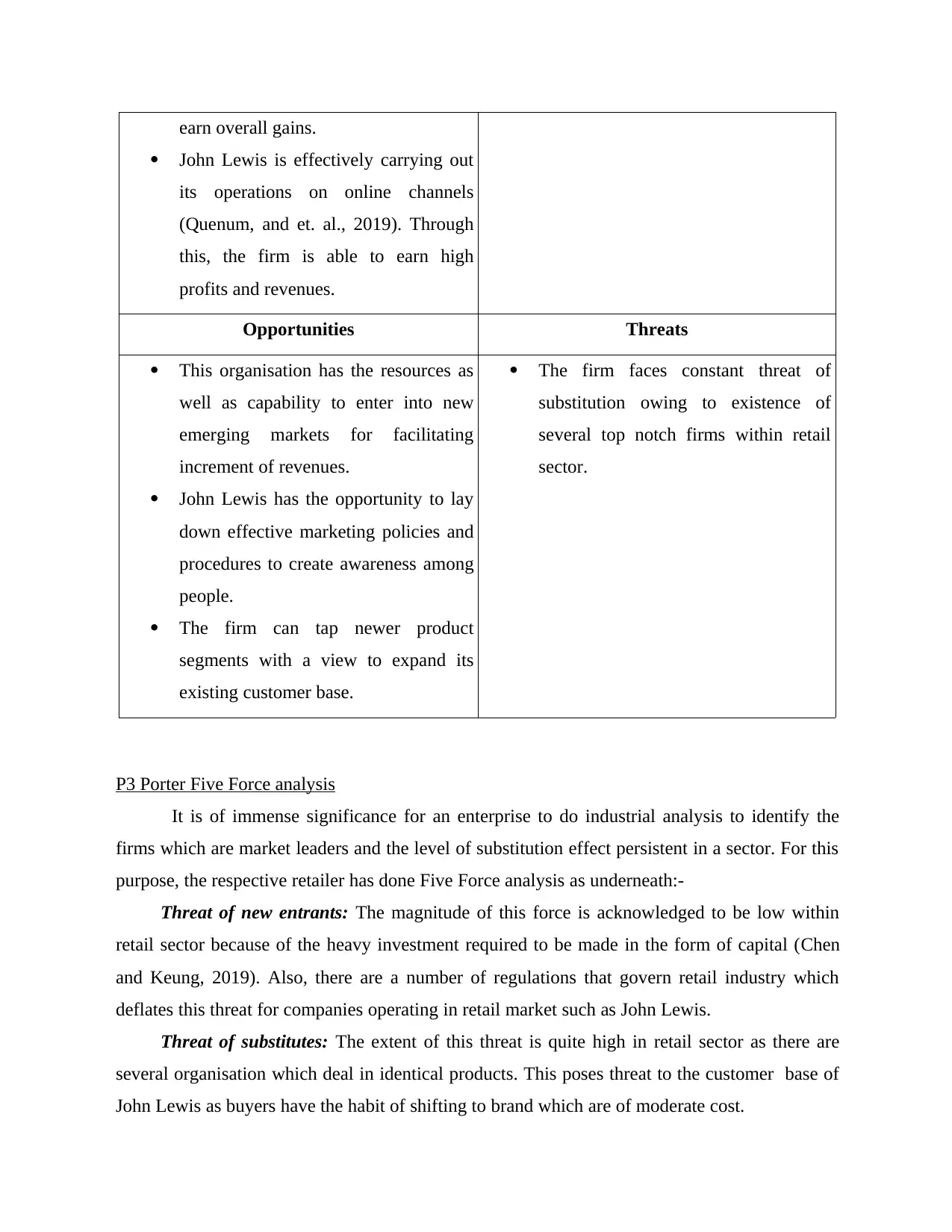
earn overall gains.
John Lewis is effectively carrying out
its operations on online channels
(Quenum, and et. al., 2019). Through
this, the firm is able to earn high
profits and revenues.
Opportunities Threats
This organisation has the resources as
well as capability to enter into new
emerging markets for facilitating
increment of revenues.
John Lewis has the opportunity to lay
down effective marketing policies and
procedures to create awareness among
people.
The firm can tap newer product
segments with a view to expand its
existing customer base.
The firm faces constant threat of
substitution owing to existence of
several top notch firms within retail
sector.
P3 Porter Five Force analysis
It is of immense significance for an enterprise to do industrial analysis to identify the
firms which are market leaders and the level of substitution effect persistent in a sector. For this
purpose, the respective retailer has done Five Force analysis as underneath:-
Threat of new entrants: The magnitude of this force is acknowledged to be low within
retail sector because of the heavy investment required to be made in the form of capital (Chen
and Keung, 2019). Also, there are a number of regulations that govern retail industry which
deflates this threat for companies operating in retail market such as John Lewis.
Threat of substitutes: The extent of this threat is quite high in retail sector as there are
several organisation which deal in identical products. This poses threat to the customer base of
John Lewis as buyers have the habit of shifting to brand which are of moderate cost.
John Lewis is effectively carrying out
its operations on online channels
(Quenum, and et. al., 2019). Through
this, the firm is able to earn high
profits and revenues.
Opportunities Threats
This organisation has the resources as
well as capability to enter into new
emerging markets for facilitating
increment of revenues.
John Lewis has the opportunity to lay
down effective marketing policies and
procedures to create awareness among
people.
The firm can tap newer product
segments with a view to expand its
existing customer base.
The firm faces constant threat of
substitution owing to existence of
several top notch firms within retail
sector.
P3 Porter Five Force analysis
It is of immense significance for an enterprise to do industrial analysis to identify the
firms which are market leaders and the level of substitution effect persistent in a sector. For this
purpose, the respective retailer has done Five Force analysis as underneath:-
Threat of new entrants: The magnitude of this force is acknowledged to be low within
retail sector because of the heavy investment required to be made in the form of capital (Chen
and Keung, 2019). Also, there are a number of regulations that govern retail industry which
deflates this threat for companies operating in retail market such as John Lewis.
Threat of substitutes: The extent of this threat is quite high in retail sector as there are
several organisation which deal in identical products. This poses threat to the customer base of
John Lewis as buyers have the habit of shifting to brand which are of moderate cost.
⊘ This is a preview!⊘
Do you want full access?
Subscribe today to unlock all pages.

Trusted by 1+ million students worldwide
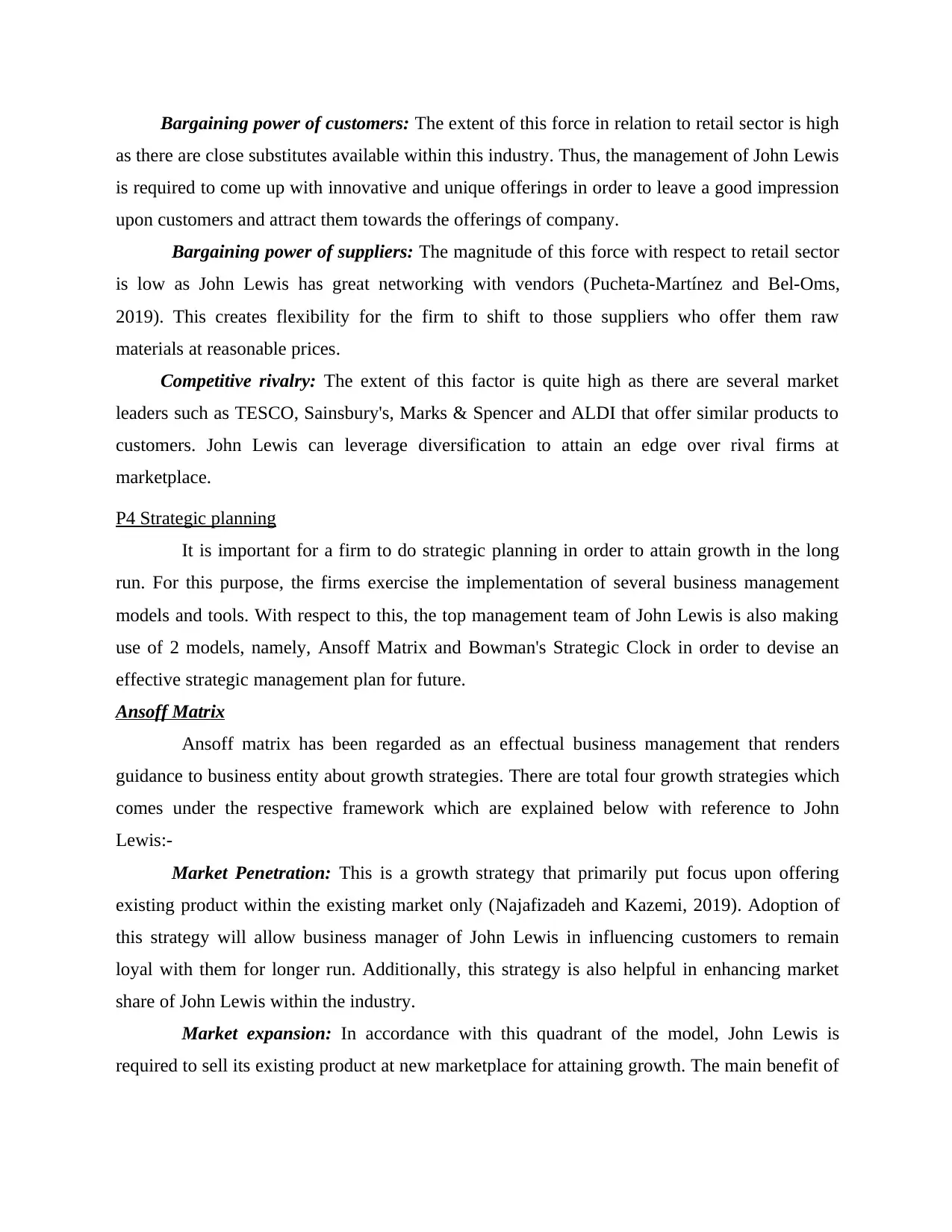
Bargaining power of customers: The extent of this force in relation to retail sector is high
as there are close substitutes available within this industry. Thus, the management of John Lewis
is required to come up with innovative and unique offerings in order to leave a good impression
upon customers and attract them towards the offerings of company.
Bargaining power of suppliers: The magnitude of this force with respect to retail sector
is low as John Lewis has great networking with vendors (Pucheta‐Martínez and Bel‐Oms,
2019). This creates flexibility for the firm to shift to those suppliers who offer them raw
materials at reasonable prices.
Competitive rivalry: The extent of this factor is quite high as there are several market
leaders such as TESCO, Sainsbury's, Marks & Spencer and ALDI that offer similar products to
customers. John Lewis can leverage diversification to attain an edge over rival firms at
marketplace.
P4 Strategic planning
It is important for a firm to do strategic planning in order to attain growth in the long
run. For this purpose, the firms exercise the implementation of several business management
models and tools. With respect to this, the top management team of John Lewis is also making
use of 2 models, namely, Ansoff Matrix and Bowman's Strategic Clock in order to devise an
effective strategic management plan for future.
Ansoff Matrix
Ansoff matrix has been regarded as an effectual business management that renders
guidance to business entity about growth strategies. There are total four growth strategies which
comes under the respective framework which are explained below with reference to John
Lewis:-
Market Penetration: This is a growth strategy that primarily put focus upon offering
existing product within the existing market only (Najafizadeh and Kazemi, 2019). Adoption of
this strategy will allow business manager of John Lewis in influencing customers to remain
loyal with them for longer run. Additionally, this strategy is also helpful in enhancing market
share of John Lewis within the industry.
Market expansion: In accordance with this quadrant of the model, John Lewis is
required to sell its existing product at new marketplace for attaining growth. The main benefit of
as there are close substitutes available within this industry. Thus, the management of John Lewis
is required to come up with innovative and unique offerings in order to leave a good impression
upon customers and attract them towards the offerings of company.
Bargaining power of suppliers: The magnitude of this force with respect to retail sector
is low as John Lewis has great networking with vendors (Pucheta‐Martínez and Bel‐Oms,
2019). This creates flexibility for the firm to shift to those suppliers who offer them raw
materials at reasonable prices.
Competitive rivalry: The extent of this factor is quite high as there are several market
leaders such as TESCO, Sainsbury's, Marks & Spencer and ALDI that offer similar products to
customers. John Lewis can leverage diversification to attain an edge over rival firms at
marketplace.
P4 Strategic planning
It is important for a firm to do strategic planning in order to attain growth in the long
run. For this purpose, the firms exercise the implementation of several business management
models and tools. With respect to this, the top management team of John Lewis is also making
use of 2 models, namely, Ansoff Matrix and Bowman's Strategic Clock in order to devise an
effective strategic management plan for future.
Ansoff Matrix
Ansoff matrix has been regarded as an effectual business management that renders
guidance to business entity about growth strategies. There are total four growth strategies which
comes under the respective framework which are explained below with reference to John
Lewis:-
Market Penetration: This is a growth strategy that primarily put focus upon offering
existing product within the existing market only (Najafizadeh and Kazemi, 2019). Adoption of
this strategy will allow business manager of John Lewis in influencing customers to remain
loyal with them for longer run. Additionally, this strategy is also helpful in enhancing market
share of John Lewis within the industry.
Market expansion: In accordance with this quadrant of the model, John Lewis is
required to sell its existing product at new marketplace for attaining growth. The main benefit of
Paraphrase This Document
Need a fresh take? Get an instant paraphrase of this document with our AI Paraphraser
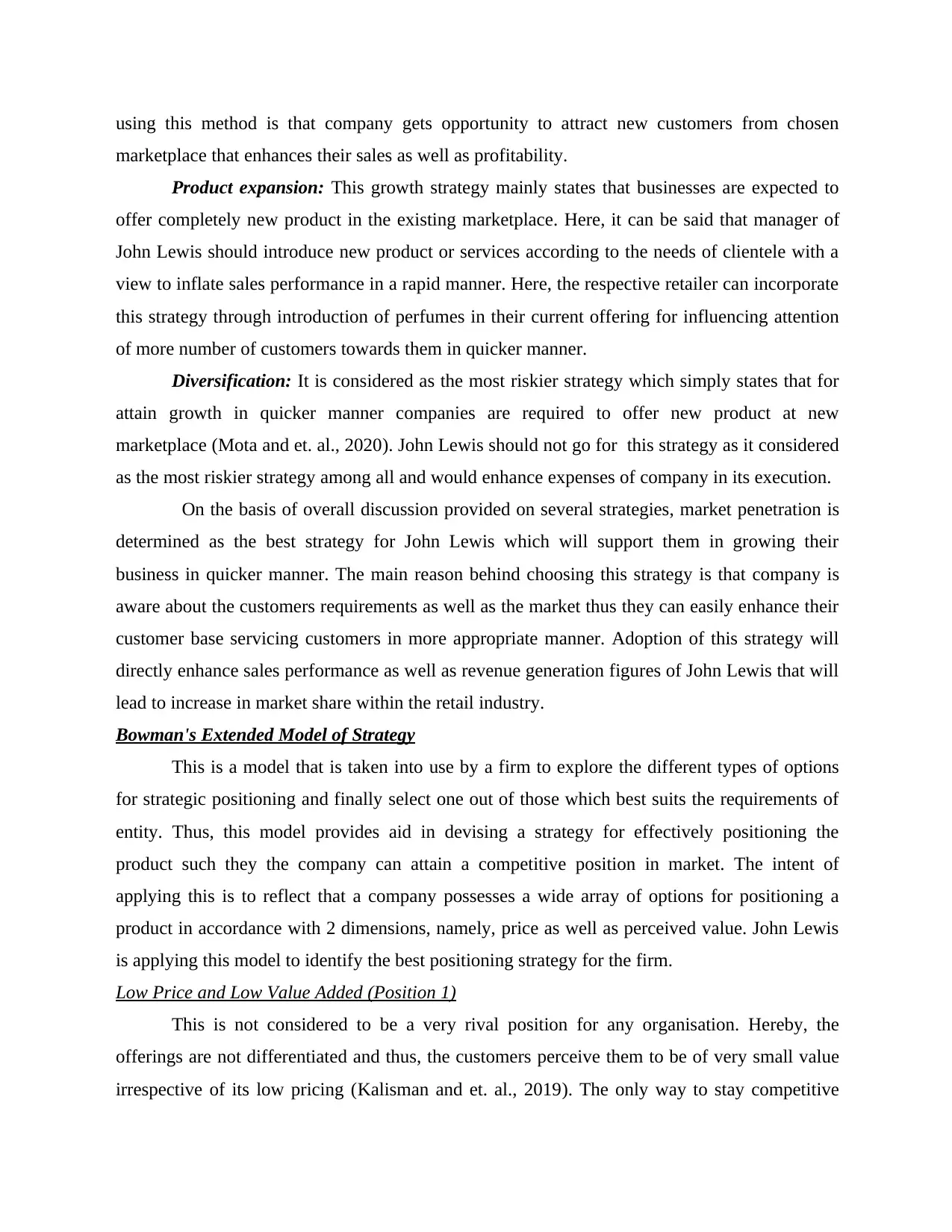
using this method is that company gets opportunity to attract new customers from chosen
marketplace that enhances their sales as well as profitability.
Product expansion: This growth strategy mainly states that businesses are expected to
offer completely new product in the existing marketplace. Here, it can be said that manager of
John Lewis should introduce new product or services according to the needs of clientele with a
view to inflate sales performance in a rapid manner. Here, the respective retailer can incorporate
this strategy through introduction of perfumes in their current offering for influencing attention
of more number of customers towards them in quicker manner.
Diversification: It is considered as the most riskier strategy which simply states that for
attain growth in quicker manner companies are required to offer new product at new
marketplace (Mota and et. al., 2020). John Lewis should not go for this strategy as it considered
as the most riskier strategy among all and would enhance expenses of company in its execution.
On the basis of overall discussion provided on several strategies, market penetration is
determined as the best strategy for John Lewis which will support them in growing their
business in quicker manner. The main reason behind choosing this strategy is that company is
aware about the customers requirements as well as the market thus they can easily enhance their
customer base servicing customers in more appropriate manner. Adoption of this strategy will
directly enhance sales performance as well as revenue generation figures of John Lewis that will
lead to increase in market share within the retail industry.
Bowman's Extended Model of Strategy
This is a model that is taken into use by a firm to explore the different types of options
for strategic positioning and finally select one out of those which best suits the requirements of
entity. Thus, this model provides aid in devising a strategy for effectively positioning the
product such they the company can attain a competitive position in market. The intent of
applying this is to reflect that a company possesses a wide array of options for positioning a
product in accordance with 2 dimensions, namely, price as well as perceived value. John Lewis
is applying this model to identify the best positioning strategy for the firm.
Low Price and Low Value Added (Position 1)
This is not considered to be a very rival position for any organisation. Hereby, the
offerings are not differentiated and thus, the customers perceive them to be of very small value
irrespective of its low pricing (Kalisman and et. al., 2019). The only way to stay competitive
marketplace that enhances their sales as well as profitability.
Product expansion: This growth strategy mainly states that businesses are expected to
offer completely new product in the existing marketplace. Here, it can be said that manager of
John Lewis should introduce new product or services according to the needs of clientele with a
view to inflate sales performance in a rapid manner. Here, the respective retailer can incorporate
this strategy through introduction of perfumes in their current offering for influencing attention
of more number of customers towards them in quicker manner.
Diversification: It is considered as the most riskier strategy which simply states that for
attain growth in quicker manner companies are required to offer new product at new
marketplace (Mota and et. al., 2020). John Lewis should not go for this strategy as it considered
as the most riskier strategy among all and would enhance expenses of company in its execution.
On the basis of overall discussion provided on several strategies, market penetration is
determined as the best strategy for John Lewis which will support them in growing their
business in quicker manner. The main reason behind choosing this strategy is that company is
aware about the customers requirements as well as the market thus they can easily enhance their
customer base servicing customers in more appropriate manner. Adoption of this strategy will
directly enhance sales performance as well as revenue generation figures of John Lewis that will
lead to increase in market share within the retail industry.
Bowman's Extended Model of Strategy
This is a model that is taken into use by a firm to explore the different types of options
for strategic positioning and finally select one out of those which best suits the requirements of
entity. Thus, this model provides aid in devising a strategy for effectively positioning the
product such they the company can attain a competitive position in market. The intent of
applying this is to reflect that a company possesses a wide array of options for positioning a
product in accordance with 2 dimensions, namely, price as well as perceived value. John Lewis
is applying this model to identify the best positioning strategy for the firm.
Low Price and Low Value Added (Position 1)
This is not considered to be a very rival position for any organisation. Hereby, the
offerings are not differentiated and thus, the customers perceive them to be of very small value
irrespective of its low pricing (Kalisman and et. al., 2019). The only way to stay competitive

herein is to exercise low cost and to operate in a manner such that no other organisation can
undercut the firm.
Low Price (Position 2)
This is a positioning strategy whereby business organisations strive to make themselves
low cost leaders at marketplace. For this purpose, the strategic course of action adopted by firm
should be aligned with minimization of cost. The profit margin on every offering hereby is low
but extensive output leads to generation of high profit.
Hybrid (Position 3)
This is a strategic position whereby some elements are of lower price than that of rival
firms while some exhibit product differentiation (Ukko and et. al., 2019). The main purpose by
exercising this position is to convince customers regarding the prevalence of good added value
in the form of reasonable prices and product differentiation.
Differentiation (Position 4)
This positioning strategy is focussed upon provision of highest level of perceived value
added to clientele. Hereby, the quality of offerings as well as branding plays a crucial role.
Focused Differentiation (Position 5)
This is a strategy which is aimed at positioning the offerings at high prices whereby the
consumers intend to purchase them owing to their high perceived value. If executed in an
effective manner, this strategy results in high profit margins. However, it is analysed that just the
best brands as well as offerings can sustain this strategy in long run.
Risky High Margins (Position 6)
This is regarded to be a high risk positioning strategy. Hereby, an organisation sets high
pricing without rendering any additional offerings such as perceived value. In this regard, it is
analysed that if consumers are willing to purchase at high prices, profits of firm are high (Pang
and et. al., 2019). However, it is later that people tend to find a better positioned offering which
gives higher perceived value for relatively lower or same pricing. This strategy is effective only
in short run.
Monopoly Pricing (Position 7)
Whereby there is a monopoly at marketplace, it implies the existence of only one firm
which offers a particular product. In this regard, the monopolist need not be much concerned
regarding the value the customers perceive of the offering. The sole choice available to
undercut the firm.
Low Price (Position 2)
This is a positioning strategy whereby business organisations strive to make themselves
low cost leaders at marketplace. For this purpose, the strategic course of action adopted by firm
should be aligned with minimization of cost. The profit margin on every offering hereby is low
but extensive output leads to generation of high profit.
Hybrid (Position 3)
This is a strategic position whereby some elements are of lower price than that of rival
firms while some exhibit product differentiation (Ukko and et. al., 2019). The main purpose by
exercising this position is to convince customers regarding the prevalence of good added value
in the form of reasonable prices and product differentiation.
Differentiation (Position 4)
This positioning strategy is focussed upon provision of highest level of perceived value
added to clientele. Hereby, the quality of offerings as well as branding plays a crucial role.
Focused Differentiation (Position 5)
This is a strategy which is aimed at positioning the offerings at high prices whereby the
consumers intend to purchase them owing to their high perceived value. If executed in an
effective manner, this strategy results in high profit margins. However, it is analysed that just the
best brands as well as offerings can sustain this strategy in long run.
Risky High Margins (Position 6)
This is regarded to be a high risk positioning strategy. Hereby, an organisation sets high
pricing without rendering any additional offerings such as perceived value. In this regard, it is
analysed that if consumers are willing to purchase at high prices, profits of firm are high (Pang
and et. al., 2019). However, it is later that people tend to find a better positioned offering which
gives higher perceived value for relatively lower or same pricing. This strategy is effective only
in short run.
Monopoly Pricing (Position 7)
Whereby there is a monopoly at marketplace, it implies the existence of only one firm
which offers a particular product. In this regard, the monopolist need not be much concerned
regarding the value the customers perceive of the offering. The sole choice available to
⊘ This is a preview!⊘
Do you want full access?
Subscribe today to unlock all pages.

Trusted by 1+ million students worldwide
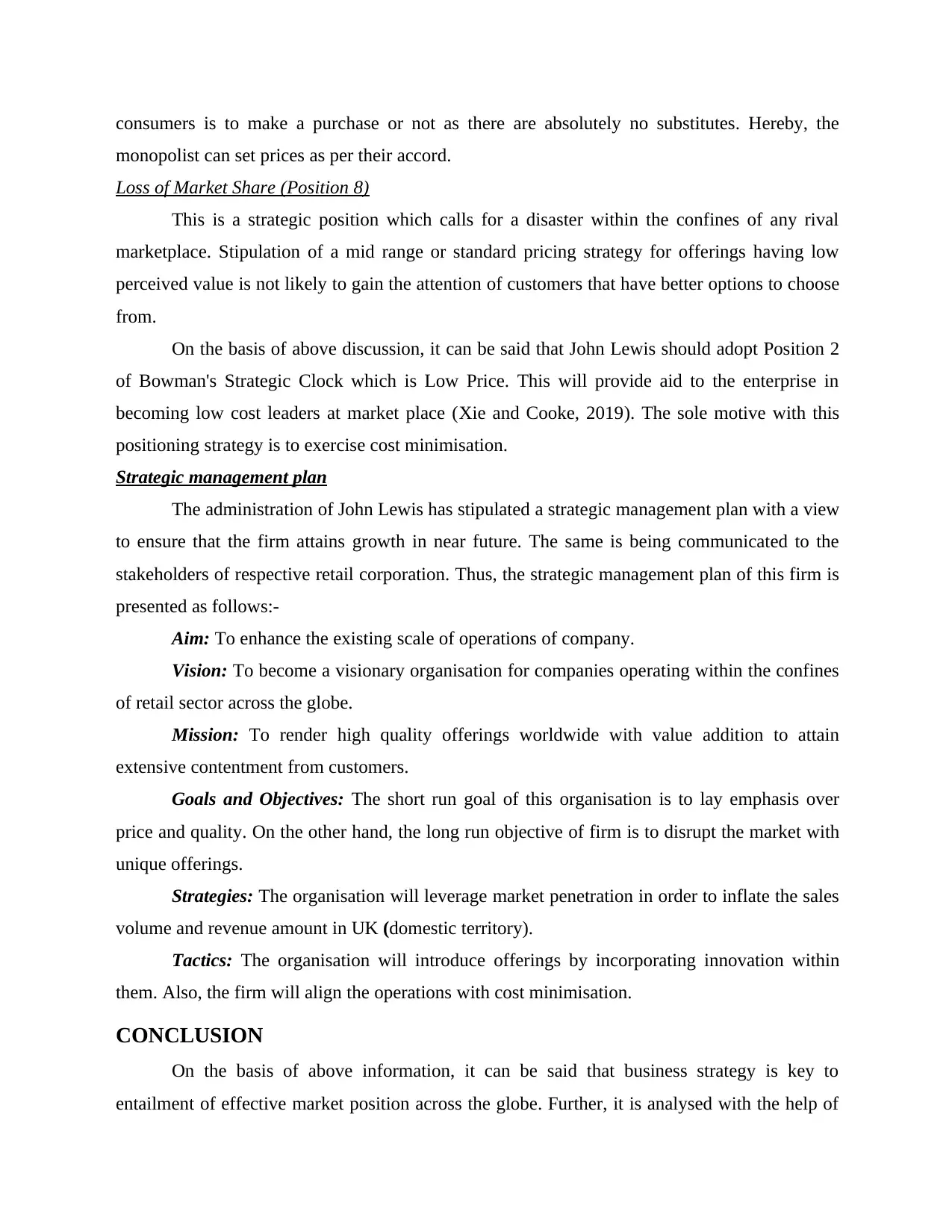
consumers is to make a purchase or not as there are absolutely no substitutes. Hereby, the
monopolist can set prices as per their accord.
Loss of Market Share (Position 8)
This is a strategic position which calls for a disaster within the confines of any rival
marketplace. Stipulation of a mid range or standard pricing strategy for offerings having low
perceived value is not likely to gain the attention of customers that have better options to choose
from.
On the basis of above discussion, it can be said that John Lewis should adopt Position 2
of Bowman's Strategic Clock which is Low Price. This will provide aid to the enterprise in
becoming low cost leaders at market place (Xie and Cooke, 2019). The sole motive with this
positioning strategy is to exercise cost minimisation.
Strategic management plan
The administration of John Lewis has stipulated a strategic management plan with a view
to ensure that the firm attains growth in near future. The same is being communicated to the
stakeholders of respective retail corporation. Thus, the strategic management plan of this firm is
presented as follows:-
Aim: To enhance the existing scale of operations of company.
Vision: To become a visionary organisation for companies operating within the confines
of retail sector across the globe.
Mission: To render high quality offerings worldwide with value addition to attain
extensive contentment from customers.
Goals and Objectives: The short run goal of this organisation is to lay emphasis over
price and quality. On the other hand, the long run objective of firm is to disrupt the market with
unique offerings.
Strategies: The organisation will leverage market penetration in order to inflate the sales
volume and revenue amount in UK (domestic territory).
Tactics: The organisation will introduce offerings by incorporating innovation within
them. Also, the firm will align the operations with cost minimisation.
CONCLUSION
On the basis of above information, it can be said that business strategy is key to
entailment of effective market position across the globe. Further, it is analysed with the help of
monopolist can set prices as per their accord.
Loss of Market Share (Position 8)
This is a strategic position which calls for a disaster within the confines of any rival
marketplace. Stipulation of a mid range or standard pricing strategy for offerings having low
perceived value is not likely to gain the attention of customers that have better options to choose
from.
On the basis of above discussion, it can be said that John Lewis should adopt Position 2
of Bowman's Strategic Clock which is Low Price. This will provide aid to the enterprise in
becoming low cost leaders at market place (Xie and Cooke, 2019). The sole motive with this
positioning strategy is to exercise cost minimisation.
Strategic management plan
The administration of John Lewis has stipulated a strategic management plan with a view
to ensure that the firm attains growth in near future. The same is being communicated to the
stakeholders of respective retail corporation. Thus, the strategic management plan of this firm is
presented as follows:-
Aim: To enhance the existing scale of operations of company.
Vision: To become a visionary organisation for companies operating within the confines
of retail sector across the globe.
Mission: To render high quality offerings worldwide with value addition to attain
extensive contentment from customers.
Goals and Objectives: The short run goal of this organisation is to lay emphasis over
price and quality. On the other hand, the long run objective of firm is to disrupt the market with
unique offerings.
Strategies: The organisation will leverage market penetration in order to inflate the sales
volume and revenue amount in UK (domestic territory).
Tactics: The organisation will introduce offerings by incorporating innovation within
them. Also, the firm will align the operations with cost minimisation.
CONCLUSION
On the basis of above information, it can be said that business strategy is key to
entailment of effective market position across the globe. Further, it is analysed with the help of
Paraphrase This Document
Need a fresh take? Get an instant paraphrase of this document with our AI Paraphraser
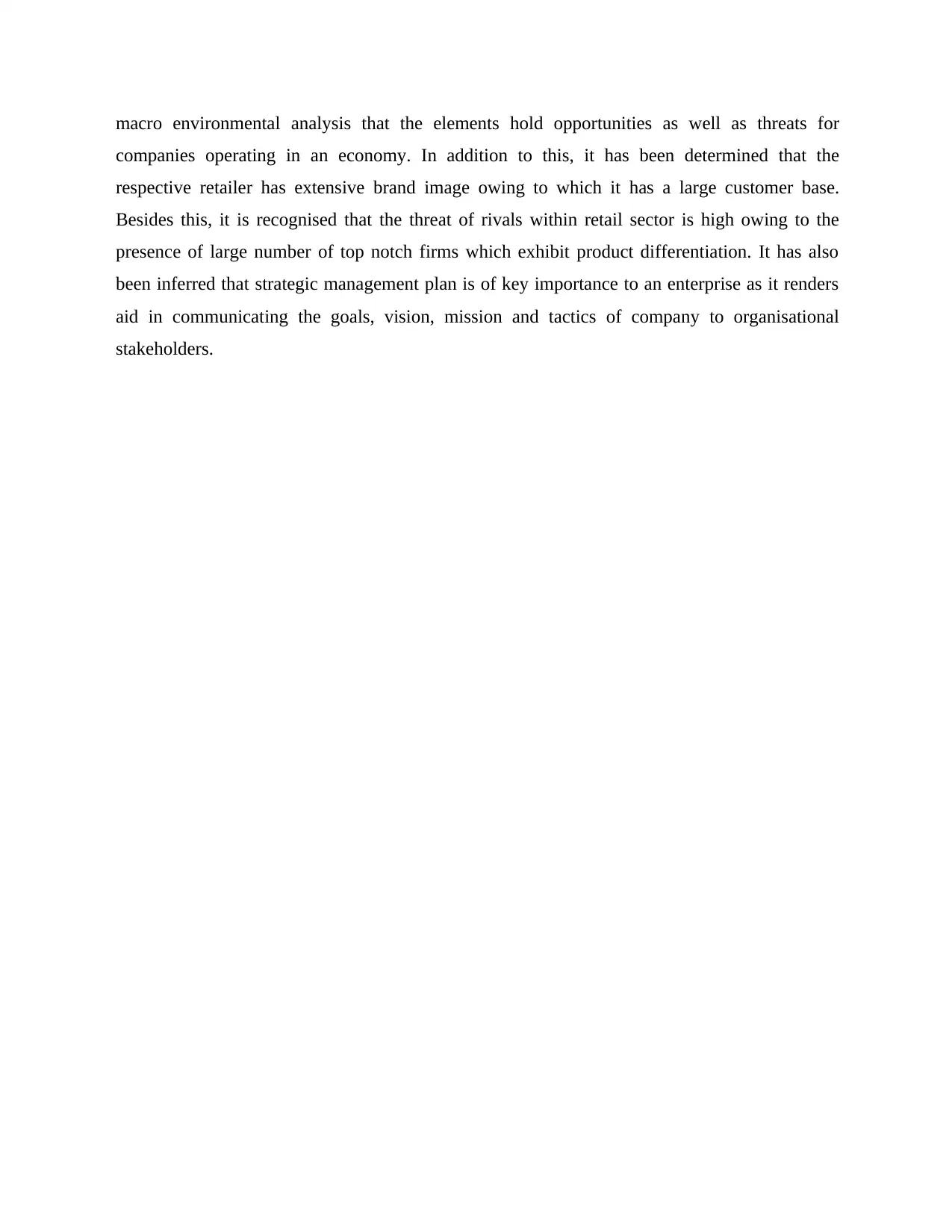
macro environmental analysis that the elements hold opportunities as well as threats for
companies operating in an economy. In addition to this, it has been determined that the
respective retailer has extensive brand image owing to which it has a large customer base.
Besides this, it is recognised that the threat of rivals within retail sector is high owing to the
presence of large number of top notch firms which exhibit product differentiation. It has also
been inferred that strategic management plan is of key importance to an enterprise as it renders
aid in communicating the goals, vision, mission and tactics of company to organisational
stakeholders.
companies operating in an economy. In addition to this, it has been determined that the
respective retailer has extensive brand image owing to which it has a large customer base.
Besides this, it is recognised that the threat of rivals within retail sector is high owing to the
presence of large number of top notch firms which exhibit product differentiation. It has also
been inferred that strategic management plan is of key importance to an enterprise as it renders
aid in communicating the goals, vision, mission and tactics of company to organisational
stakeholders.
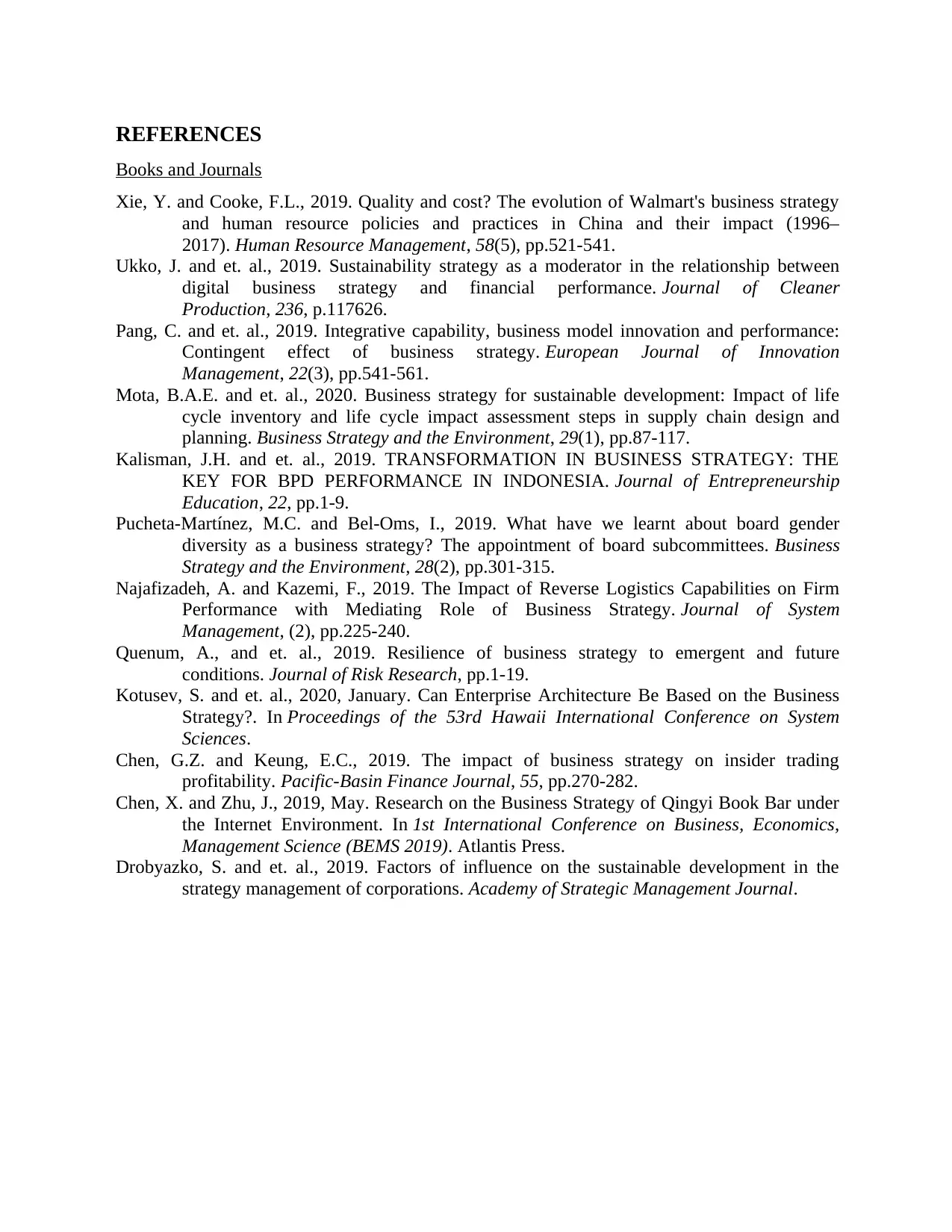
REFERENCES
Books and Journals
Xie, Y. and Cooke, F.L., 2019. Quality and cost? The evolution of Walmart's business strategy
and human resource policies and practices in China and their impact (1996–
2017). Human Resource Management, 58(5), pp.521-541.
Ukko, J. and et. al., 2019. Sustainability strategy as a moderator in the relationship between
digital business strategy and financial performance. Journal of Cleaner
Production, 236, p.117626.
Pang, C. and et. al., 2019. Integrative capability, business model innovation and performance:
Contingent effect of business strategy. European Journal of Innovation
Management, 22(3), pp.541-561.
Mota, B.A.E. and et. al., 2020. Business strategy for sustainable development: Impact of life
cycle inventory and life cycle impact assessment steps in supply chain design and
planning. Business Strategy and the Environment, 29(1), pp.87-117.
Kalisman, J.H. and et. al., 2019. TRANSFORMATION IN BUSINESS STRATEGY: THE
KEY FOR BPD PERFORMANCE IN INDONESIA. Journal of Entrepreneurship
Education, 22, pp.1-9.
Pucheta‐Martínez, M.C. and Bel‐Oms, I., 2019. What have we learnt about board gender
diversity as a business strategy? The appointment of board subcommittees. Business
Strategy and the Environment, 28(2), pp.301-315.
Najafizadeh, A. and Kazemi, F., 2019. The Impact of Reverse Logistics Capabilities on Firm
Performance with Mediating Role of Business Strategy. Journal of System
Management, (2), pp.225-240.
Quenum, A., and et. al., 2019. Resilience of business strategy to emergent and future
conditions. Journal of Risk Research, pp.1-19.
Kotusev, S. and et. al., 2020, January. Can Enterprise Architecture Be Based on the Business
Strategy?. In Proceedings of the 53rd Hawaii International Conference on System
Sciences.
Chen, G.Z. and Keung, E.C., 2019. The impact of business strategy on insider trading
profitability. Pacific-Basin Finance Journal, 55, pp.270-282.
Chen, X. and Zhu, J., 2019, May. Research on the Business Strategy of Qingyi Book Bar under
the Internet Environment. In 1st International Conference on Business, Economics,
Management Science (BEMS 2019). Atlantis Press.
Drobyazko, S. and et. al., 2019. Factors of influence on the sustainable development in the
strategy management of corporations. Academy of Strategic Management Journal.
Books and Journals
Xie, Y. and Cooke, F.L., 2019. Quality and cost? The evolution of Walmart's business strategy
and human resource policies and practices in China and their impact (1996–
2017). Human Resource Management, 58(5), pp.521-541.
Ukko, J. and et. al., 2019. Sustainability strategy as a moderator in the relationship between
digital business strategy and financial performance. Journal of Cleaner
Production, 236, p.117626.
Pang, C. and et. al., 2019. Integrative capability, business model innovation and performance:
Contingent effect of business strategy. European Journal of Innovation
Management, 22(3), pp.541-561.
Mota, B.A.E. and et. al., 2020. Business strategy for sustainable development: Impact of life
cycle inventory and life cycle impact assessment steps in supply chain design and
planning. Business Strategy and the Environment, 29(1), pp.87-117.
Kalisman, J.H. and et. al., 2019. TRANSFORMATION IN BUSINESS STRATEGY: THE
KEY FOR BPD PERFORMANCE IN INDONESIA. Journal of Entrepreneurship
Education, 22, pp.1-9.
Pucheta‐Martínez, M.C. and Bel‐Oms, I., 2019. What have we learnt about board gender
diversity as a business strategy? The appointment of board subcommittees. Business
Strategy and the Environment, 28(2), pp.301-315.
Najafizadeh, A. and Kazemi, F., 2019. The Impact of Reverse Logistics Capabilities on Firm
Performance with Mediating Role of Business Strategy. Journal of System
Management, (2), pp.225-240.
Quenum, A., and et. al., 2019. Resilience of business strategy to emergent and future
conditions. Journal of Risk Research, pp.1-19.
Kotusev, S. and et. al., 2020, January. Can Enterprise Architecture Be Based on the Business
Strategy?. In Proceedings of the 53rd Hawaii International Conference on System
Sciences.
Chen, G.Z. and Keung, E.C., 2019. The impact of business strategy on insider trading
profitability. Pacific-Basin Finance Journal, 55, pp.270-282.
Chen, X. and Zhu, J., 2019, May. Research on the Business Strategy of Qingyi Book Bar under
the Internet Environment. In 1st International Conference on Business, Economics,
Management Science (BEMS 2019). Atlantis Press.
Drobyazko, S. and et. al., 2019. Factors of influence on the sustainable development in the
strategy management of corporations. Academy of Strategic Management Journal.
⊘ This is a preview!⊘
Do you want full access?
Subscribe today to unlock all pages.

Trusted by 1+ million students worldwide
1 out of 12
Related Documents
Your All-in-One AI-Powered Toolkit for Academic Success.
+13062052269
info@desklib.com
Available 24*7 on WhatsApp / Email
![[object Object]](/_next/static/media/star-bottom.7253800d.svg)
Unlock your academic potential
Copyright © 2020–2025 A2Z Services. All Rights Reserved. Developed and managed by ZUCOL.





